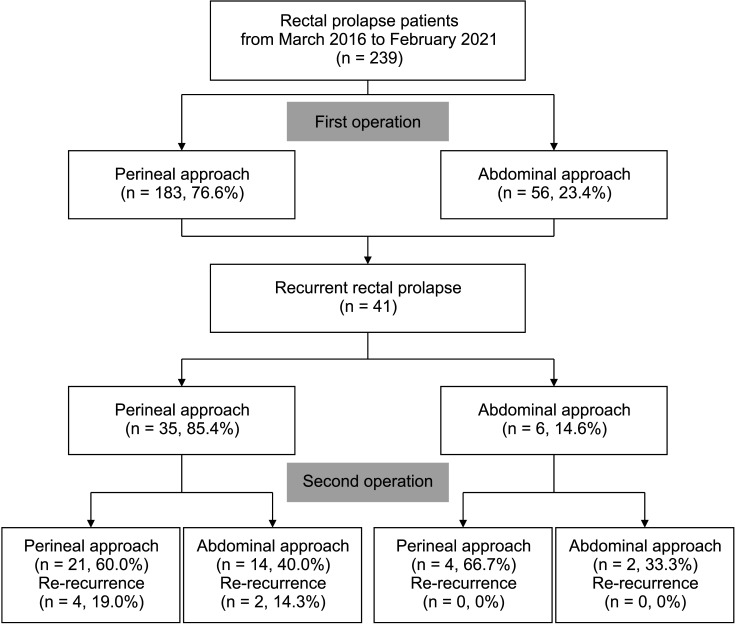Ann Surg Treat Res.
2023 Mar;104(3):150-155. 10.4174/astr.2023.104.3.150.
Comparison of abdominal and perineal approach for recurrent rectal prolapse
- Affiliations
-
- 1Department of Surgery, Chonnam National University Hospital, Gwangju, Korea
- 2Department of Surgery, Chonnam National University Medical School, Gwangju, Korea
- KMID: 2539693
- DOI: http://doi.org/10.4174/astr.2023.104.3.150
Abstract
- Purpose
Rectal prolapse is a benign disease in which the rectum protrudes below the anus. Although many studies have been reported on the treatment of primary rectal prolapse for many years, there is a lack of treatment or clinical research results on recurrent rectal prolapse. This study aimed to evaluate the outcomes of surgical approaches for recurrent rectal prolapse.
Methods
We studied patients who underwent surgical treatment for recurrent rectal prolapse disease from March 2016 to February 2021. We analyzed the previous operation methods in patients with recurrent rectal prolapse, as well as the operation time, complication rate, hospital stay, and re-recurrence rates in the perineal and abdominal approach groups.
Results
Out of a total of 239 patients, 41 patients who underwent surgery for recurrent rectal prolapse were retrospectively enrolled. Recurrent rectal prolapses were surgically treated either by the perineal approach (n = 25, 61.0%) or by the abdominal approach (n = 16, 39.0%). The operation times were significantly longer in the abdominal approach than in the perineal approach (98.44 minutes vs. 58.00 minutes, P = 0.001). Hospital stay was significantly longer in the abdominal approach than in the perineal approach (9.19 days vs. 6.00 days, P = 0.012). Re-recurrence rate after repeat repair was not significantly different between the 2 groups (P = 0.777).
Conclusion
Although the perineal approach shortened the operation time and hospital stay, there were no significant differences between the 2 groups in postoperative complications and re-recurrence rate. Both approaches can be good surgical options for the treatment of recurrent rectal prolapse.
Keyword
Figure
Reference
-
1. Steele SR, Varma MG, Prichard D, Bharucha AE, Vogler SA, Erdogan A, et al. The evolution of evaluation and management of urinary or fecal incontinence and pelvic organ prolapse. Curr Probl Surg. 2015; 52:92–136. PMID: 25933741.2. Neshatian L, Lee A, Trickey AW, Arnow KD, Gurland BH. Rectal prolapse: age-related differences in clinical presentation and what bothers women most. Dis Colon Rectum. 2021; 64:609–616. PMID: 33496475.3. Wijffels NA, Collinson R, Cunningham C, Lindsey I. What is the natural history of internal rectal prolapse? Colorectal Dis. 2010; 12:822–830. PMID: 19508530.4. Michalopoulos A, Papadopoulos VN, Panidis S, Apostolidis S, Mekras A, Duros V, et al. Surgical management of rectal prolapse. Tech Coloproctol. 2011; 15 Suppl 1:S25–S28. PMID: 21887563.5. Bordeianou L, Hicks CW, Kaiser AM, Alavi K, Sudan R, Wise PE. Rectal prolapse: an overview of clinical features, diagnosis, and patient-specific management strategies. J Gastrointest Surg. 2014; 18:1059–1069. PMID: 24352613.6. Formijne Jonkers HA, Draaisma WA, Wexner SD, Broeders IA, Bemelman WA, Lindsey I, et al. Evaluation and surgical treatment of rectal prolapse: an international survey. Colorectal Dis. 2013; 15:115–119. PMID: 22726304.7. Emile SH, Elbanna H, Youssef M, Thabet W, Omar W, Elshobaky A, et al. Laparoscopic ventral mesh rectopexy vs Delorme’s operation in management of complete rectal prolapse: a prospective randomized study. Colorectal Dis. 2017; 19:50–57. PMID: 27225971.8. Senapati A, Gray RG, Middleton LJ, Harding J, Hills RK, Armitage NC, et al. PROSPER: a randomised comparison of surgical treatments for rectal prolapse. Colorectal Dis. 2013; 15:858–868. PMID: 23461778.9. Kairaluoma MV, Kellokumpu IH. Epidemiologic aspects of complete rectal prolapse. Scand J Surg. 2005; 94:207–210. PMID: 16259169.10. Kim DS, Tsang CB, Wong WD, Lowry AC, Goldberg SM, Madoff RD. Complete rectal prolapse: evolution of management and results. Dis Colon Rectum. 1999; 42:460–469. PMID: 10215045.11. Hool GR, Hull TL, Fazio VW. Surgical treatment of recurrent complete rectal prolapse: a thirty-year experience. Dis Colon Rectum. 1997; 40:270–272. PMID: 9118739.12. Fengler SA, Pearl RK, Prasad ML, Orsay CP, Cintron JR, Hambrick E, et al. Management of recurrent rectal prolapse. Dis Colon Rectum. 1997; 40:832–834. PMID: 9221862.13. Hong KD, Hyun K, Um JW, Yoon SG, Hwang DY, Shin J, et al. Clinical outcomes of surgical management for recurrent rectal prolapse: a multicenter retrospective study. Ann Surg Treat Res. 2022; 102:234–240. PMID: 35475228.14. Solomon MJ, Young CJ, Eyers AA, Roberts RA. Randomized clinical trial of laparoscopic versus open abdominal rectopexy for rectal prolapse. Br J Surg. 2002; 89:35–39. PMID: 11851660.15. Steele SR, Goetz LH, Minami S, Madoff RD, Mellgren AF, Parker SC. Management of recurrent rectal prolapse: surgical approach influences outcome. Dis Colon Rectum. 2006; 49:440–445. PMID: 16465585.
- Full Text Links
- Actions
-
Cited
- CITED
-
- Close
- Share
- Similar articles
-
- Clinical outcomes of surgical management for recurrent rectal prolapse: a multicenter retrospective study
- Surgical Treatment of Rectal Prolapse: A 10-Year Experience at a Single Institution
- Complete Rectal Prolapse Combined with Rectal Cancer: A Case Report
- Comparative analysis of operative procedures in rectal prolapse between perineal and abdominal approach
- Changing Trend of Rectal Prolapse Surgery in the Era of the Minimally Invasive Surgery


